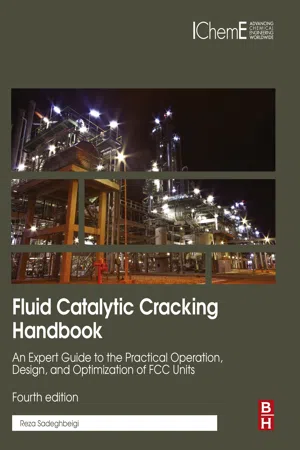
Fluid Catalytic Cracking Handbook
An Expert Guide to the Practical Operation, Design, and Optimization of FCC Units
Reza Sadeghbeigi
- 392 pagine
- English
- ePUB (disponibile sull'app)
- Disponibile su iOS e Android
Fluid Catalytic Cracking Handbook
An Expert Guide to the Practical Operation, Design, and Optimization of FCC Units
Reza Sadeghbeigi
Informazioni sul libro
Fluid Catalytic Cracking Handbook: An Expert Guide to the Practical Operation, Design, and Optimization of FCC Units, Fourth Edition, enables readers to maximize the profitability and reliability of fluid catalytic cracking operations by covering all stages of FCC, including their design, operation, troubleshooting and optimization. It includes valuable chapters on FCC Main Fractionator and Gas Plant and Process Engineering Tools that provide engineers with the relevant tools they need to fully optimize processes and operations. This book presents technologies and processes that will improve the profitability and reliability of FCC units, along with lessons from Mr. Sadeghbeigi's 30 years of field experience.
The book provides a valuable reference for experienced engineers, but is also an ideal reference for those who are developing their skills and knowledge base.
- Presents relevant, real world examples that enable petrochemical engineers to achieve real term savings
- Contains dedicated chapters on lessons learned from troubleshooting cases carried out by the author
- Includes sections on FCC Main Fractionator and Gas Plant
- Covers both SI and Imperial Units throughout
Domande frequenti
Informazioni
Fluid catalytic cracking process description—converter section
Abstract
Keywords
- 1. UOP (Universal Oil Products)
- 2. Kellogg Brown & Root - KBR (formerly The M.W. Kellogg Company)
- 3. ExxonMobil Research and Engineering (EMRE)
- 4. The Technip—Stone & Webster.
- 5. CB&I Lummus
- 6. Shell Global Solutions International
| 1915 | Almer M. McAfee of Gulf Refining Co. discovered that a Friedel-Crafts aluminum chloride catalyst could catalytically crack heavy oil. However, the high cost of catalyst prevented the widespread use of McAfee's process. |
|---|---|
| 1922 | The French mechanical engineer named Eugene Jules Houdry and a French pharmacist named E.A. Prodhomme set up a laboratory to develop a catalytic process for conversion of lignite to gasoline. The demonstration plant in 1929 showed the process not be economical. Houdry had found that Fuller's Earth; a clay containing aluminosilicate (Al2SiO6) could convert oil from lignite to gasoline. |
| 1930 | The Vacuum Oil Company invited Houdry to move his laboratory to Paulsboro, New Jersey. |
| 1931 | The Vacuum Oil Company merged with Standard Oil of New York (Socony) to form Socony-Vacuum Oil Company. |
| 1933 | A small Houdry unit processing 200 BPD of petroleum oil was commissioned because of the economic depression of the early 1930s; Socony-Vacuum could not support Houdry's work and granted him permission to seek help elsewhere. Sun Oil Company joined in developing Houdry's process. |
| 1936 | Socony-Vacuum converted an old thermal cracker to catalytically crack 2000 BPD of petroleum oil using the Houdry process. |
| 1936 | Use of natural clays as catalyst greatly improved cracking efficiency. |
| 1937 | Sun Oil began operation of Houdry unit processing 12,000 BPD. The Houdry process used reactors with a fixed bed of catalyst and it was a semi-batch operation. Almost 50% of the cracked products were gasoline. |
| 1938 | With the commercial successes of ... |
Indice dei contenuti
- Cover image
- Title page
- Table of Contents
- Copyright
- Dedication
- About the Author
- Preface to the Fourth Edition
- Chapter 1. Fluid catalytic cracking process description—converter section
- Chapter 2. Process description main fractionator, gas plant and product treating sections
- Chapter 3. Process control instrumentation
- Chapter 4. FCC feed characterization
- Chapter 5. FCC catalysts
- Chapter 6. Catalyst and feed additives
- Chapter 7. Chemistry of FCC reactions
- Chapter 8. Unit monitoring and control
- Chapter 9. Products and economics
- Chapter 10. Effective project execution and management
- Chapter 11. Refractory lining systems
- Chapter 12. Process and mechanical design guidelines for FCC equipment
- Chapter 13. Troubleshooting
- Chapter 14. Optimization and debottlenecking
- Chapter 15. Emissions
- Chapter 16. Residue and deep hydrotreated feedstock processing
- Chapter 17. Biofuels
- Appendix 1. Temperature variation of liquid viscosity
- Appendix 2. Correction to volumetric average boiling point
- Appendix 3. Total correlations
- Appendix 4. n–d–M correlations
- Appendix 5. Estimation of molecular weight of petroleum oils from viscosity measurements
- Appendix 6. Kinematic viscosity to Saybolt universal viscosity
- Appendix 7. API correlations
- Appendix 8. Definitions of fluidization terms
- Appendix 9. Conversion of ASTM 50% point to TBP 50% point temperature
- Appendix 10. Determination of TBP cut points from ASTM D86
- Appendix 11. Nominal pipe sizes
- Appendix 12. Conversion factors
- Glossary
- Index